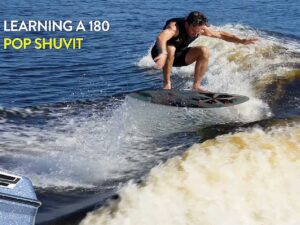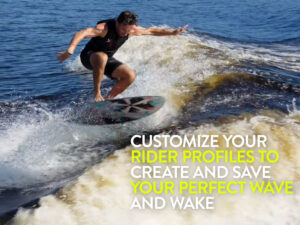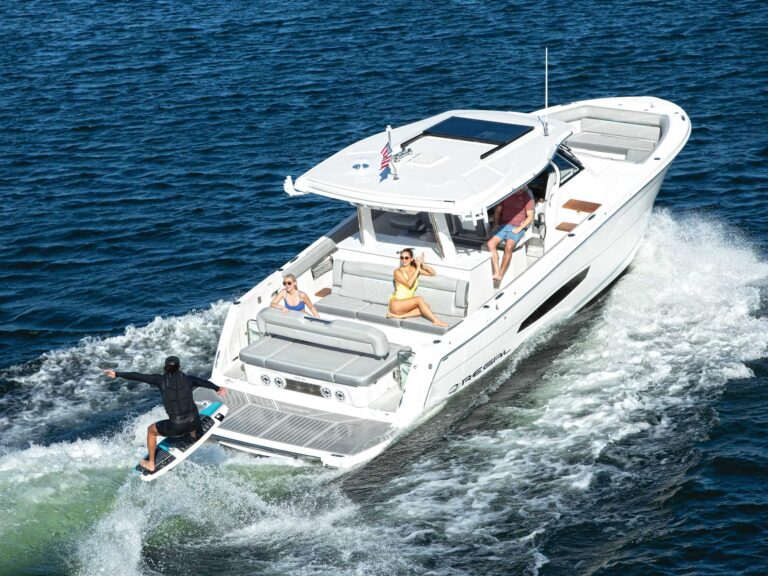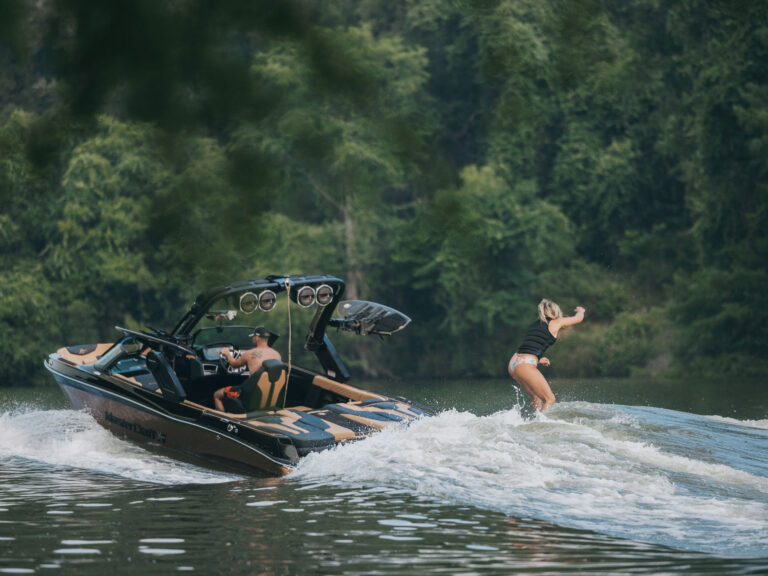Wake 180s
Wake 180s are one of your first tricks combining elements of jumping and spinning. Here is where learning all four variations of your one- and two-wake jumps really pays off. By learning all four you’ll already know how to take off and land frontside and backside from both sides of the wake. Now all you have to do is add the spin. First-timers usually find the one-wake frontside half-cab (frontside approach, back to front) the easiest to learn. Do a deepwater switchstance start, then cut outside the wake about 3-5 feet. Edge in on your toes with the handle in a control position. One of the biggest keys to successful 180s is to jump into the air before trying to turn. Once you clear the wake, initiate the spin by moving the handle across your body and opening your hips to the boat. Keep the handle in as you land backside in your normal stance.
Quick tip: There are several ways to get into the fakie position. A deepwater switchstance start is the easiest. You can also try a sliding 180 out wide in the flats or behind the boat. Bunny-hop 180s are easy too, once you get the hang of jumping, turning and controlling the line.
Two-Wake 180s
By now you should have learned the four one-wake 180 turns. You should also be comfortable with the four wake jumps. Now it’s time to build on those skills to pull off wake-to-wake turns that look and feel good.
Wake 180s are often described as being frontside (toes to the wake approach) or backside (heels to the wake approach). If you perform the turn front to back it’s called an air 180, and if you perform the turn from back to front it’s called a half-cab.
Loading the line becomes more important with any trick that goes wake-to-wake or beyond, and that means this one. Use consistent technique and the line tension to your benefit.
To get set for a backside air 180, cut out about 15-25 feet and get set up for a backside approach. Turn in slow on a tight line. Approach the crest with the same speed that you use for wake jumps. As you near the wake keep your weight on your heels and handle in.
Spring off the wake by quickly extending your legs. Ride all the way to the top of the wake and pop straight up. Wait until you clear the wakes to initiate the turn. Throwing the turn too soon is a common mistake. Once airborne, pivot your lower body and let your board float around.
Proper handle position is important. Pull it across your body to help with the spin and keep it in near your stomach for maximum control. Some riders find it easier to release the rear hand while landing. That’s OK as long as you maintain control of the line tension.
As you near the opposite wake, get set for a controlled splashdown. Make sure your board is pointing in the same direction as your path across the wakes. Land on the downside of the wake with a 40-60 weight distribution between your front and back foot. Flow into the landing by bending your knees and riding smoothly away.
As you advance, it’s time to add your own style. Try throwing in a rail, nose or tail grab. How about delaying the turn to the front until the last split second? Once you’ve got the basic move down, it’s easy to interject your own technique to call it your own.
Problem: I don’t make it wake to wake.
Solution: Distance across the wake is based on your line load and strength of pop. Increase one or both until you hit the mark. Shortening the rope so that the wakes are narrower is another quick fix.
Problem: I lose my axis.
Solution: First, make ssure that when springing off the wake you are not throwing your shoulders back. Pop with your legs driving the shoulders upward. Next, always keep the handle in near your stomach. Letting the handle out at any point during your trick will tilt your axis.
Problem: My landing is hard to control.
Solution: Use proper position to splash down. Point the nose in the same direction you’re traveling. Keep the handle in and bend your knees to absorb the shock of the landing. Also, maybe fiddle with your fin size. A bigger fin may help the board track better on landings.







